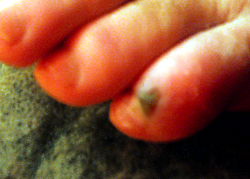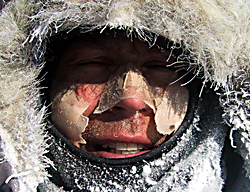Frostbite and Frostnip

Very common
Frostnip/frostbite is most common in toes, fingers, nose and cheeks. You can almost count on it and it is uncommon to arrive the Pole without it.
Stage one (Frostnip) shows as white or pale yellow patches, with a strong burning sensation when tissue is re-warmed. Frostnip will result in temporary loss of sensation in the affected area for up to one year.
Stage two is red swelling of the area (often visible in the evening) followed by blue spots, often visible in the morning or right after travel.
If untreated, the spots will grow into black areas (Frostbite) and stage three. The final stage of Frostbite is blood-poisoning (septicaemia) which can be fatal. Frostnip (white/red/light blue patches) can be reversed if treated in time. Frostbite (black) can be kept stable but will not heal until after you have left the ice.
Prevention is the key. Good blood circulation is essential. Take blood thinners such as aspirin, Ginko Biloba, Omega 3 and garlic.
Feet
Make sure that your boots are big enough for your toes to move around. Opt for one size too large rather than perfect fit (try out the boots with all socks and vapor barriers on). Powder your feet every morning and night, and tape heels and toes (not too tight) with medical paper tape. This is crucial. The powder keeps your skin dry, prevent sores and rashes, the tape prevents sores.

Hands
Use oversized mittens, never gloves. Gloves separate the fingers and restrain them from warming each other. Wear thin, synthetic gloves only inside the mittens and keep them on at all times, especially during camp work, camera handling and other fine-tuned tasks that call for temporary removing of mittens. Isolate mittens with quick-dry synthetic wool or real wool. Mittens should be cotton for NP and Gore-Tex for SP. Attach straps to prevent the mittens from blowing away in the wind when temporary off.
Adjust your ski poles for proper length. Prepare with wide hand loops. Isolate grips with foam and duct tape.

Face
Tape areas in your face that are exposed to the wind (glitches between mask and goggles, the nose tip). Use medical paper tape. Cover your face with a hard mask, especially at the South Pole, to protect from the wind chill. Use sunscreen only on very hot days, when your face is uncovered. (Sunscreen clogs the skin and even freezes on top of it). Use lip balm with sunscreen and take a multivitamin to prevent cold sores. Check your partner for white spots on the nose and the cheeks. Stand still for no longer than a few minutes in severe cold wind and face away from the wind at breaks.
Avoid and treat
Don't touch metal with bare fingers. Don't touch fuel with bare skin. Check your toes, fingers and face every evening for trouble spots. Toss hot water bottles (tomorrows drinking water) in your sleeping bag at night.
Frostnip and frostbite can be stalled, even reversed during the expedition with close attention and treatment. Loosen your boots, tape (unless swollen) and powder well. Keep warm in camp and use Hotronics on travel in severe cold. Frostbite is very painful at night and will affect your sleep for some time. Take strong painkillers and possibly a sleeping aid. We do not recommend antibiotics treatment at this point unless you are in the very final days of the expedition, as it might interfere with a possible cure for the more serious stage of severe frostbite.
In spite of generally colder temperatures, severe frostbite is not as common in the polar areas as it is in mountaineering. Alpine climbing adds to frostbite due to the lack of oxygen at altitude.
Frostnip and mild frostbite instead is far more common in the polar areas than in the Himalayas due to prolonged exposure to cold in combination with high winds. You should be alright in temperatures above -30C if you take preventive care and don't suffer from blood conditions such as high cholesterol.
If bad frostbite does enter however (severe black areas), you should consider to terminate the expedition and check yourself for signs of blood-poisoning (swollen glands, dark blue stripe marks running out from the area towards the heart and/or high fever) while waiting for the flight out. Take antibiotics (check with your doctor) if any of those symptoms should occur and seek immediate emergency rescue.